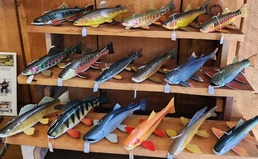
Through Ice and Snow They Go
How the GT County Road Commission and TART Trails keep our paths clear
By Anna Faller | Dec. 17, 2022
There is nothing quite so unpredictable as a Michigan winter. Though it’s true that a handful of weeks each year can be relied on for snow and sub-arctic temperatures, the rest of the season is anyone’s guess. Wintery weather does have one common feature, though: how it’s handled once it hits the ground.
For the scoop on this year’s snow removal, Northern Express caught up with the Grand Traverse County Road Commission (GTCRC) and TART Trails to talk about winter service for infrastructure, from major roads to pedestrian trails.
Our biggest takeaway? There’s snow such thing as being too prepared.
GRAND TRAVERSE COUNTY ROAD COMMISSION
Human Power
For GTCRC, keeping up with snow-removal is often a question of proper staffing. According to Superintendent Jay Saksewski, a fully-fledged field operations team (those are the fearless men and women plowing and salting in blizzard conditions) should comprise about 31 people.
In recent years, however, the commission has barely hit two-thirds of its target, thanks in large part to a competitive market and complex commercial driver’s license (CDL) qualifications. “That’s when you start [asking yourself] who’s going to plow the roads,” Saksewski says.
In response to their dwindling numbers, GTCRC launched a program through which applicants can earn their license, regardless of past work experience. “While we’ve always helped train [new employees],” says Saksewski, formally tracking that licensure process and offering it to those sans credentials has proved an invaluable marketing tool.
So far, this year’s field operations crew is just one member shy of completion, at least six of whom earned their license from scratch, courtesy of the commission’s new program. “It’s brought in people from outside industries that have a passion to serve the community,” he says. “We’re [seeing] some really great success.”
Horse Power
That success is also largely determined by GTCRC’s winter equipment. This year, its tandem axle trucks—the brick-shaped behemoths we recognize as standard plows—were first on the list of tech upgrades.
“Traditionally, they have a ‘belly blade’ that scrapes the snow between the tires,” says Saksewski. Much of the GTCRC’s fleet, however, is also equipped with “winged” blades that drop down at an angle to the vehicle. The modification increases each truck’s capacity by almost 50 percent, and, when compared to the price of a full replacement—which can cost hundreds of thousands of dollars—is significantly less expensive.
Saksewski says, “Historically, a truck might have taken two laps to clear the traffic lane and the shoulder. Now it can do them [both] at once, and that improves our efficacy.”
Other mechanical tech includes a chemical process called salt “pre-wetting,” wherein halite rock salt is mixed with chloride and a sugary byproduct, like beet juice. As a result, the thicker salt consistency not only keeps it to a specified area instead of “bouncing around like dice,” but also increases its potency by making it adaptable to temperature fluctuations.
That so-called Beet Heet came into use for the City of Traverse City in the winter of 2020-21 in an effort to source less corrosive and more biodegradable contents for our roads. It has also allowed the city to decrease its salt use and save money in the process.
Chemical magic notwithstanding, unpredictable weather continues to challenge GTCRC operations. “There’s no denying that our climates are changing, and what that means for snowfall is hard to say,” notes Saksewski.
To mitigate Mother Nature’s many variables, GTCRC abides by “worst case scenario” preparation, which includes blending its salt mix with sand—this not only ups the mixture’s efficacy, but also lessens environmental impact—as well as purchasing enough extra material to last the entire winter season.
As the icing on the high-tech cake, drivers county-wide can likely look forward to live data in the next year. “There’s [already] an application on our website [gtcrc.org] called Citizen Reporter,” says Saksewski, wherein users can report road problems and send them to a field operations foreman. The commission, however, also has goals of distributing real-time updates, including of-the-moment snapshots and vehicle materials tracking.
“We’re invested in [finding] more effective ways of pushing the snow and scooping the dirt,” he says. “The support we get to explore these different approaches has been a game changer for us.”
TART TRAILS
Community Connections
In addition to typical motorized roads, pedestrian paths are an equally-critical avenue of area winter transport, more than 100 miles of which are kept up by the TART Trails network.
This hasn’t always been the case, though. In fact, the puzzle-like system through which TART clears its trails has only existed for the last decade. Prior to then, says Communications and Policy Director Brian Beauchamp, “sidewalks and roads would be cleared, but the TART and non-motorized trails were an afterthought.” Consequently, snow and ice built up, rendering paths unnavigable and forcing frequenters to wait until spring to enjoy them.
In response, TART Trails’ administration, sparked by the zeal of one Dr. Tom Auer—a former TART board president and overall champion of snow-removal—united with a team of community partners—including The City of Traverse City, Grand Traverse County, and Acme and East Bay Townships—to create a plan to ensure that trails stay clear for recreation year-round.
“It’s been wonderful to see the steady increase in use since we started doing this,” says Beauchamp. “We’ve found it’s critical to stay on top of [trail clearing] so that people can come to expect that and use them.”
As Trail Management and Planning Director Chris Kushman informs us, the framework is sorted into three figurative “buckets,” the first of which is city maintenance. He says, “Within [Grand Traverse] city limits, it’s the city that does the bulk of snow removal on the TART Trail system,” all of which is facilitated, staffed, and equipped by the organization’s partners.
Volunteer Efforts
Outside of Traverse City, TART Trail snow removal is either covered by volunteers or managed on a contract basis in cooperation with township governments (East Bay and Acme, for example) where trail topography requires specialized equipment that TART Trails can’t provide.
“It really comes down to whether the trail has any segments, [like a boardwalk], where we couldn’t run a truck and a plow without damaging [it],” Kushman explains.
As the TART Trails system continues to grow, upkeep of new segments—such as the Boardman Lake Loop and Acme Connector Trail—then falls under the corresponding umbrella, depending upon the trail’s location.
The final piece of the clearing puzzle comprises the TART Trail’s volunteer network, who groom and maintain more than 20 miles of winter recreational paths.
“It’s a real labor of love,” says Beauchamp.
Their work begins on the Leelanau Trail (between DeYoung Natural Area and Suttons Bay), and extends along the Muncie Lakes Pathway and even parts of the VASA Trailhead. All in all, Beauchamp estimates that a core group of about 20 individuals put in a whopping 1,000 hours each year—and that’s not even counting the staff who manage smaller projects. “This community is incredibly generous with their time and talent,” he says. “It’s something our staff doesn’t take for granted.”
As TART continues to widen its motorless network, including a handful of active projects, overall trail use has followed suit. In fact, Beauchamp informs us that TART’s trail traffic has increased a whopping 30 percent since the start of the pandemic. On a broader scale, TART has also observed a 20 percent annual spike in winter activity since implementing snow removal.
And more trail junkies mean more volunteers. Says Beauchamp, “A big part of what we do is engaging with new folks. Every time we develop a new trail, we’re looking to foster a community to contribute.” Those interested can get involved through the Volunteer tab on the TART Trails website or by monitoring TART's online presence for opportunities and informational sessions.
“Our goal within this context is making every home a trail head,” Beauchamp says, “so that no matter where you live, you have access to non-motorized activity that works for you. When that happens, the whole region benefits.”
Trending

The Art of the Decoy
On mantles and shelves around the country (and indeed, around the world) sit intricate and beautiful wooden fish decoys that… Read More >>
Wreath the Halls
Get ready for the holidays with the ultimate wreath workshop! Boyne Mountain hosts Wreathfest, Saturday, Nov. 8, with Kalin … Read More >>
TC Beer Week Is Back!
Traverse City will be getting sudsy this weekend, as Traverse City Beer Week returns Nov. 7-15. This year, each day has a th… Read More >>


